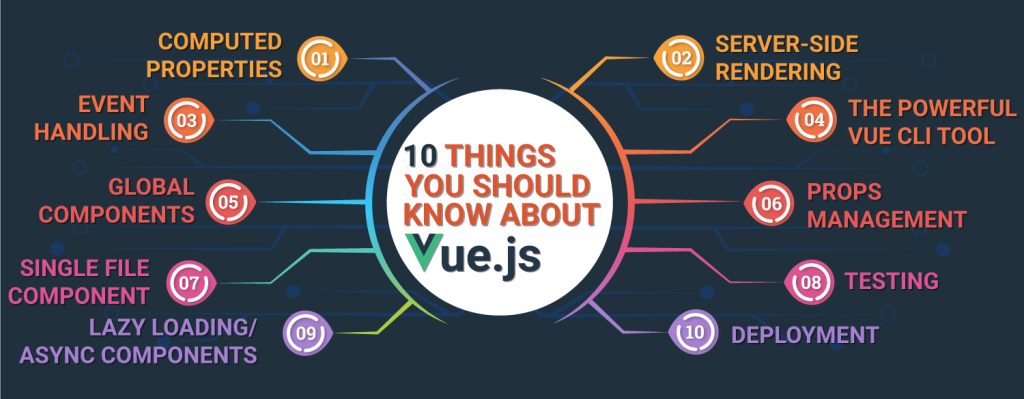One of the most popular businesses is software development applications in recent times. The developers use different devices and strategies for launching successful applications. The developers use many software technologies that make applications more appealing, quicker, and easy to understand. Vue.js is one of them. Here we are to discuss 10 Interesting things you need to know about Vue.js web development.
Table of Contents
ToggleWhat is Vue.js Web?
Evan, the creator of Vue.js. According to him:
“Vue.js is like a flexible tool that doesn’t force its way of doing things on you. It’s mainly a layer for making web pages more interactive, and you can use it as a small part of a webpage, not just for big complex applications.”
Vue.js is used by web development companies worldwide. It has a simple core for handling what you see on a web page and extra tools to make complex single-page apps easier to manage
It consists of an approachable core library that focuses on the view layer and an ecosystem of supporting libraries that helps you tackle complexity in large Single-Page Applications.
Why Do Developers Use Vue.js?
The following are the reasons behind the developer’s use of Vue.js over custom web application development:-
1. Virtual Dom
It is a clone of the vital DOM component and is available as JavaScript data structures. The original data structure is compared to the changes made to the JavaScript data structures. Just the final changes are reflected in the real DOM, which users have the option to see. It is cost-effective with rapid changes.
2. Two-way Data Binding
This feature is known as Two-way data binding because of its MVVM architecture. This feature makes sure that any changes made in your user interface are passed to the data and changes done in your data.
3. CSS Transactions
It provides several methods for applying transaction effects to HTML elements when added or removed from the DOM.
4. Simpler API
It has a simple API and design for a web developer. It is used to build a Simple single-page application in a single day.
5. Virtual Nodes
Vue.js allows users to write their templates in an HTML or JavaScript file.
6. A Great Tooling Feature
Vue.js has a great tooling feature: the new Vue CLI to start a new project with state store, Unit testing, CSS preprocessors, linting, PWA, etc.
7. Tracks Component Dependencies
It tracks component dependencies during render. It lets already know the system and which components require re-rendering when the form changes.
8. Easy and Simple to Learn
It is easy to learn and is an ideal choice for startups.
Advantages and Disadvantages of Vue.js
We discussed the features of Vue.js. Now, it’s time to discuss the advantages & disadvantages of Vue.js.
Advantages
Here are the positive aspects of the Vue.js framework. It provides lots of functionality among which a few are indicated below:
1. Tiny Size
It has a very tiny downloadable size of 18 KB compared to the other frameworks of large downloaded sizes.
2. Single-file Component and Readability
It uses component-based architecture. In vue.js, everything is a component. Each component is written with HTML, CSS, and JavaScript, encouraging readability and simplicity.
3. Easy to use
It is easy for any beginner to use with just a little practice.
4. Code readability
The code is easier to understand and read because all the components are stored in separate files. It makes it easier to maintain and fix.
5. Component reusability
Encapsulated components are chunks of code. It can be reused as templates for similar system elements.
6. Easy to learn
It does not require depth knowledge of JSX and TypeScript to understand. Only you have the basic knowledge of HTML, CSS, and JavaScript.
Read Also: How To Choose the Best cross-platform frameworks for app development
Disadvantages
The following are the cons of Vue.js.
1. Data Updates Can Get Tricky
Vue.js has a helpful feature that connects data between parts of a web page. However, Vue.js can sometimes be a bit tricky when it comes to updating data, and you might need to handle it carefully. You can learn more about these challenges on the Vue.js website.
2. Language Barrier
Initially, it was difficult for non-Chinese-speaking developers. Now it supports in many languages. But, there are some languages with less support than the others.
3. Over-flexibility Risks
It is very flexible and easy to use. Therefore, it’s easy to have lots of spaghetti codes everywhere.
4. Lack of Experienced Developers
Vue js is a young technology that just started gaining popularity. It is not as big as React or Angular. It needs time for mass adoption.
10 Things You Should Know About Vue.js

1. Creating Editable Properties
Vue.js allows you to make properties that you can change and work with. This helps you show data nicely and do various things like formatting or changing values. Computed Properties can simplify your code by handling these tasks, but using them too much can make your code harder to manage.
2. Event handling
We can utilize the von directive, which we abbreviated to the @ symbol, to listen to DOM events and run some JavaScript when executed. The utilization would be von:click= “handler” or with the shortcut, @click= “handler”.
The handler value can be one of the following:
- Inline handlers: Inline JavaScript is to be executed when the event is triggered (similar to the native onclick attribute).
- Method handlers: A property name or path that points to a method defined on the component.
3. Lazy loading/ Async components
It is one of the best performance hacks for Vue.js that will significantly reduce the file size, HTTP request-response time, and so on, where components are added and rendered on demand. It supports code splitting.
4. Global components
Global components are an essential feature. It can save lots of time in time registering components individually every time. However, it can be misused by registering all components globally. As of result, it can lead to a large build size resulting in poor Search Engine Optimization(SEO) and slower page load time.
5. Single file component
In Vue.js, a single file component is a great feature. It lets you wrap up HTML, CSS, and JavaScript together for reusable code.
6. Testing
It is a fundamental part of custom software development that makes the process easy for adding new features and tracking down bugs by executing the minor code units in isolation. It helps other developers to understand what your component does.
7. Vue CLI
The Vue CLI Tool is a powerful tool that lets you test components on their own easily. The best part is that you can develop and test a component in isolation, making changes and seeing them instantly.
8. Props Management
It is a particular keyword in Vue.js and It passes data from a parent component to one of its child components. It is easier as compared to state management libraries.
9. Server-side rendering
Server-side rendering enhances the performance of Vue.js and similar client-side frameworks. It helps generate web pages on the server and delivers fully rendered pages to users, resulting in improved efficiency and user experience.
10. Deployment
Vue.js makes it easy to go from working on your project to sharing it with the world. It handles issues and technical stuff for you, so you don’t have to worry about warnings, errors, or big files. It does all the behind-the-scenes work to make your project run smoothly when it’s live on the internet. It’s like having a helpful assistant for deployment.
Simple App or Enterprise Empire? DreamSoft4u builds Vue.js apps that scale.
Connect with our team
Conclusion
In this article, we have discussed the definition of Vue.js, its features, its pros & cons, and its benefits. We also mentioned the ten things you need to know about Vue.js web development. We hope the article helps to understand Vue.js web development in detail.
FAQ’S
Q1: Vue.js web development – What type of app can I build?
Vue.js is a versatile tool. It can help you create a whole range of apps:
- Simple & complex apps
- Single-page apps (SPAs)
- Progressive web apps (PWAs)
Q2: Can I use Vue.js to add new features to my app?
Yes, you can create dynamic dashboards, add data visualization features, and add tons of other interactive elements.
Q3: Can you name some popular apps built using Vue.js?
Yes, there is a whole list of popular platforms.
- Facebook uses Vue.js to enhance its user interface
- Netflix uses Vue. js to make the whole streaming experience better for users.
- Grammarly, a popular tool among writers, uses Vue.js too.
Many other popular platforms such as Trivago and Nintendo utilize Vue.js in one way or another.
Q4: How experienced are your Vue.js developers and designers?
Our developers have extensive experience, They can project of all scales and sizes- from startups to enterprise-grade apps. DS4U is a leading app development company with 19+ years of experience and clients worldwide.
Q5: How can I discuss my Vue.js requirements?
Please visit our Contact Us page. Once you are there fill in the details, and our team will get back to you soon.










